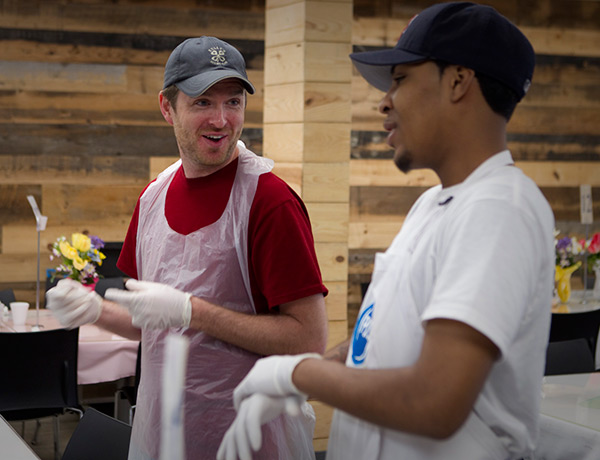‘Arguing is part of life. It’s how you deal with the arguing that is important.’
By Linda Coutant | February 8, 2017
Conflict. It’s something many people prefer to avoid in personal and professional relationships, but Appalachian State University’s Skip Rackmill offers a different perspective that may help people use conflict to build bridges.
“Conflict is neither positive nor negative – it just is,” said Rackmill, an award-winning First Year Seminar instructor.
“Arguing is part of life. It’s how you deal with the arguing that is important – how you view it, how you respond to it. What really annoys Person A can be insignificant to Person B. What one person sees as catastrophic, another person might say, ‘Well, it’s not so bad.’”
Two common approaches to conflict – the fight method and the denial method – are counterproductive, according to Rackmill, who has expertise in education and martial arts. “Most people fall back on one of those approaches. It’s the enlightened person who realizes there’s a healthier approach out there,” he said.
“Issues of conflict and prejudice arise when there’s a breakdown in connection,” explained Rackmill, who has helped educate residence life staff in dealing with conflict and University Police in how to de-escalate potentially volatile situations. “If you know people, prejudice tends to drop off. If you know people, you have more compassion.”
In the absence of connection and compassion, Rackmill offers these general tips for helping to resolve conflict:
Don’t make assumptions.
In his work with students, Rackmill said resolving conflict takes collaboration and critical thinking, such as not making assumptions and being OK with having one’s assumptions challenged. These skills are important for people of all ages, he said.
“The old adage is true about when you assume: you make an ass out of you and me. An assumption is like a hypothesis; it is true or not. Test it, and then be able to reject it if the data does not substantiate it. Assumptions are based on past experiences or history. Try being somewhat futuristic about other possible outcomes.”
Practice active listening.
“In most conflicts, people are not listening. They have their own agenda, their own set of conditions. We’re patterned in conflict to either win or lose,” said Rackmill. Typically, neither side is 100 percent correct. “It’s usually somewhere in the middle,” he said. “When we’re having an argument with someone, what happens in communication, the person isn’t really listening. They’re waiting for you to take a breath and then they jump in. So, active listening is really important. Do you hear what the person is saying?”
This practice can involve facing the speaker and maintaining eye contact, paying attention and not interrupting, keeping an open mind, asking open-ended questions to ensure understanding, and giving feedback as to what you are hearing.
Active listening doesn’t mean abdicating your position, Rackmill said. Rather, it’s trying to see where the other person is coming from and what they’re concerned with. In the best circumstances, both sides have a more enlightened view after active listening.
Be proactive, not reactive.
Rackmill said potential conflict can be deflected by admitting mistakes ahead of time and acknowledging our shared humanity.
“Most of us tend to be reactive. We react to a situation, and when we react we usually react out of negative feelings, such as anger. Being proactive in altercations is another powerful tool, because if you allow the person you’re arguing with to be rooted in their belief, it’s probably too late because you have to undo a certain amount of layers to make a connection.”
Once while riding in the car with his father, Rackmill observed his dad pull into a parking space that another driver was waiting for. Upon getting out of the car, Rackmill said he chose to admit the mistake to the other driver and passenger, who he had watched scowling at them. After this brief, light-hearted exchange, the other driver and passenger immediately shifted into a more understanding attitude, he said.
Get centered.
Being centered is “when you’re in the present moment, you’re connected, you’re relaxed,” Rackmill said. “To be centered is a very powerful state.” The Japanese Martial art Aikido is predicated on love and reconciliation, relying on an internal centering ability to diffuse conflict, he said. To become centered, he recommends using mindfulness to focus on the breath and to consciously breathe deeply from the belly using the diaphragm, as opposed to shallow breathing from the chest. Belly breathing stimulates the parasympathetic nervous system and naturally calms the body.
Rackmill said, “The founder of Aikido martial arts once said it’s OK to lose your center, but if you’re a true Aikidoist, you better regain it quickly. I love that because what he’s saying is no one is perfect.”
Use ‘I’ statements.
Statements that begin with “I” versus “you” are helpful in conflict situations. Saying “I feel happy, sad or angry when I see this happening,” as opposed to “You make me happy, sad or angry,” can impact how smoothly a conversation progresses because it reduces the likelihood of the other person becoming triggered.
“There’s a big difference in this style of communicating,” Rackmill said. “As soon as you say ‘you,’ the other person gets back on their heels, gets defensive and they’re not really listening any longer.”
Stay positive.
Use positivity when addressing unpleasant behavior, Rackmill said. “Always start out with something positive, because by doing that, the door stays open. In times of argument, it may be hard to come up with something positive, but if you can come up with a phrase to move the conversation along, it can be helpful.”
When he supervised student teachers and gave them feedback on their teaching, Rackmill said he always started with some form of praise, even when their performance was poor. “Also, watch your language. Don’t use loaded words such as ‘never’ or ‘always,’” he recommended.
Become resilient.
Resiliency is the ability to overcome setbacks. “This is really important. If you can be resilient, it’s a tremendous strength,” Rackmill said. Some ways to become more resilient are to accept criticism in a positive manner, see perceived mistakes as an opportunity to learn and grow, and refrain from catastrophizing. Mindfulness training is another. Rackmill said he also likes to remember the author Anais Nin’s famous quote: “We don’t see things as they are, we see them as we are.”


2016 Brantz Award winner
In 2016, Skip Rackmill received Appalachian’s Rennie W. Brantz Award for Outstanding Teaching in the First Year Seminar. The award honors an instructor who demonstrates exemplary teaching and has made an impact on student lives in the First Year Seminar classroom. Learn more
Educator and martial artist
Skip Rackmill was a special education teacher for 30 years and has practiced martial arts for 45 years. He blends these two loves into his teaching.Special education speaks to meeting a person where they are and having compassion; the physicality of martial arts presents metaphors for verbal confrontations, while its development of internal energy can deflect confrontation, he said.

5 tips for enacting social change from Appalachian’s Ombuds Office
Want to work toward meaningful social change? Ombuds Bob Hill offers five tips for acting on your conscience in challenging times.